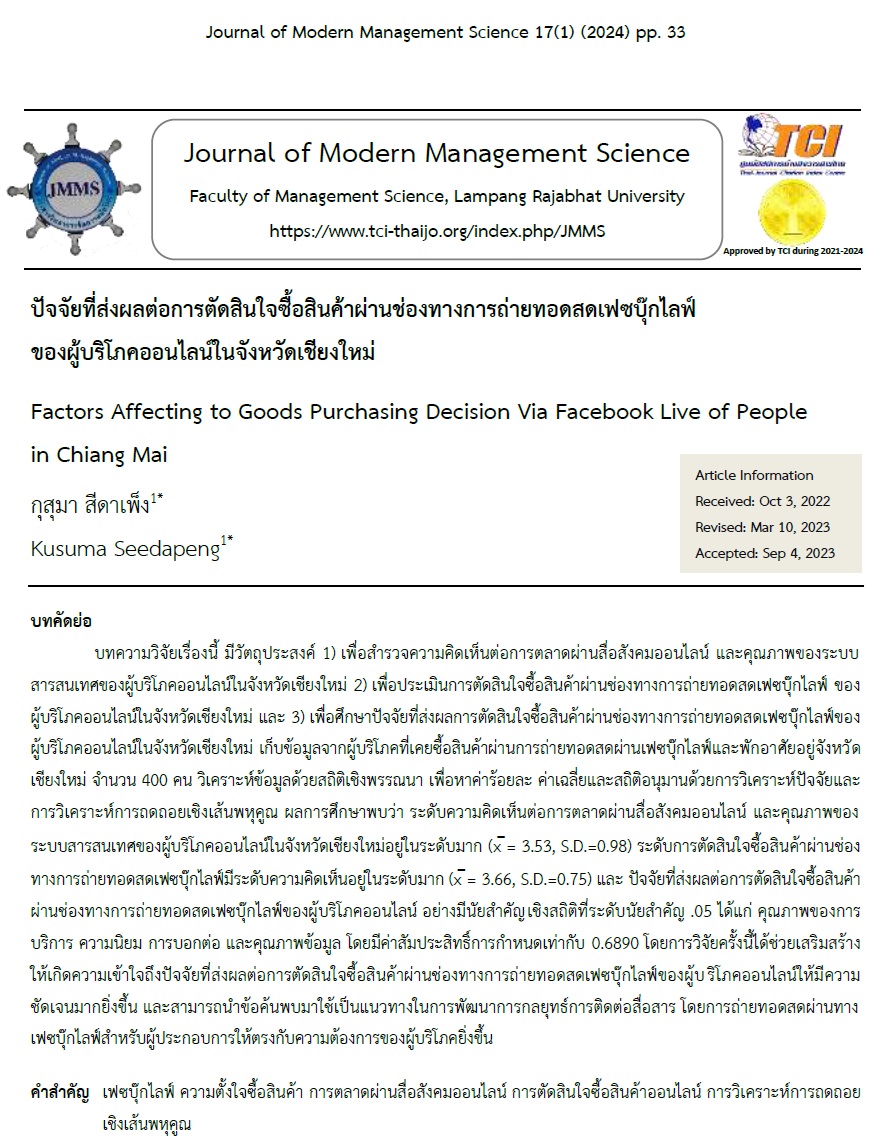Factors Affecting to Goods Purchasing Decision Via Facebook Live of People in Chiang Mai
Main Article Content
Abstract
The objectives of this research are: 1) to investigate the attitudes towards online marketing and the quality of information systems among online consumers in Chiang Mai province, 2) to evaluate the purchasing decisions of online consumers in Chiang Mai province through Facebook Live, and 3) to study the factors that influence the purchasing decisions of online consumers in Chiang Mai province through Facebook Live. The researcher collected data from 400 consumers who had purchased products via Facebook Live and lived in Chiang Mai. Descriptive statistics were used to present percentages and means. In addition, inferential statistics were employed to draw factor analysis and multiple linear regression analysis. The study found that the level of opinion towards marketing through social media and the quality of information systems of online consumers in Chiang Mai province is high. ( 3.53, S.D. = 0.98). Secondly, the level of purchasing decision-making through Facebook Live streaming has a high level of opinion. ( 3.66, S.D. = 0.75). Finally, factors affecting online consumers' purchasing decisions via the Facebook Live broadcasting channel were statistically significant at a .05 level, including service quality, popularity, word of mouth, and data quality, which can be predicted at 68.90%. This research has helped to enhance the understanding of the factors affecting purchasing decisions through Facebook Live streaming among online consumers. These findings can also be used as guidelines for developing communication strategies using Facebook Live streaming for businesses that better meet the needs of consumers and align with their preferences.
Article Details

This work is licensed under a Creative Commons Attribution-NonCommercial-NoDerivatives 4.0 International License.
The article must be considered and accepted for publication by the editorial board of the Faculty of Management Science, Lampang Rajabhat University. The articles have been reviewed by a peer (peer review) and the author must update according to the suggestion if available before publication. Articles that are not considered the editorial team will inform the results of the consideration but will not send the original to the author.
JMMS is the Faculty of Management Science journal, Lampang Rajabhat University. Jmms published both print and online editions. We allow the use of articles for academic use under the scope of copyright law.
References
กระทรวงเทคโนโลยีสารสนเทศและการสื่อสาร. (2563). รายงานผลการสำรวจพฤติกรรมผู้ใช้อินเทอร์เน็ตในประเทศไทย. กรุงเทพมหานคร: กระทรวงเทคโนโลยีสารสนเทศและการสื่อสาร.
จำนง พรายแย้มแข. (2529). เทคนิคการวัดผลและการประเมินผล. กรุงเทพฯ : ไทยวัฒนาพานิช.
จีรนันท์ กาญจนสิทธิ์ และนิตนา ฐานิตธนกร. (2559). ปัจจัยที่ส่งผลต่อความตั้งใจไปท่องเที่ยวต่างประเทศซ้ำของนักท่องเที่ยวชาวไทย. ในการประชุมวิชาการนำเสนอผลงานวิจัยระดับบัณฑิตศึกษา ครั้งที่ 12. กรุงเทพมหานคร: มหาวิทยาลัยราชภัฏพระนคร.30(1). 6-17.
ฉัตยาพร เสมอใจ. (2550). พฤติกรรมผู้บริโภค. กรุงเทพมหานคร: วีพรินท์.
ณัฐพัชร์ ล้อประเสริฐ. (2549). สำรวจความพึงพอใจของลูกค้า. กรุงเทพมหานคร: สถาบันเพิ่มผลผลิตแห่งชาติ.
ธงชัย สันติวงษ์. (2538). พฤติกรรมองค์การ. กรุงเทพมหานคร: ไทยวัฒนาพานิช.
ธนพงศ์ กำเหนิดชูตระกูล และนิตนา ฐานิตธนกร. (2559). ปัจจัยการบอกต่อการจัดอันดับและการวิจารณ์สินค้าคุณภาพของข้อมูลและการบริการที่มีอิทธิพลต่อความสำเร็จของผู้ประกอบการ ขายเสื้อผ้าแฟชั่นผ่านทางสังคมออนไลน์พาณิชย์อิเล็กทรอนิกส์ (S-commerce) ในเขต กรุงเทพมหานคร. ในการประชุมวิชาการระดับชาติสหวิทยาการเอเชียอาคเนย์ 2559 ครั้งที่ 3. นนทบุรี: โรงแรมริชมอนด์ สไตลิส คอนเวนชั่น. 30(1). 19-33.
พิศุทธิ์ อุปถัมภ์และนิตนา ฐานิตธนกร.(2557).ความไว้วางใจและลักษณะธุรกิจผ่านสื่อสังคมออนไลน์ที่ส่งผลต่อความตั้งใจซื้อสินค้าผ่านสื่อสังคมออนไลน์.(พิมพ์ครั้งที่ 4). นนทบุรี:มหาวิทยาลัยสุโขทัยธรรมาธิราช.
วิทวัส รุ่งเรืองผล. (2558). ตำราหลักการตลาด. กรุงเทพฯ : มาร์เก็ตติ้งมูฟ.
สํานักงานพัฒนาธุรกรรมทางอิเล็กทรอนิกส์. (2559). ผลการสำรวจพฤติกรรมผู้ใช้อินเทอร์เน็ตในประเทศไทย. สืบค้น 10มกราคม 2565. จาก https://data.go.th/
Chang, S.E., Liu, A.Y., & Shen, W.C. (2017). User trust in social networking services: A comparison of Facebook and Linkedln. Computer in Human Behaviour, 69(1). 207-217.
Chu, S.C., & Kim, Y. (2011). Determinants of consumer engagement in electronic word-of-mouth (e-wom) in social networking sites. International Journal of Advertising, 30(1).47-75.
Delone, W.H. and Mclean, E.R. (1992) Information Systems Success: The Quest for the Dependent Variable. Information Systems Research, 3(4). 60-95.
Delone, W.H. & Mclean, E.R. (2003) The Delone and Mclean Model of Information System Success: A Ten-Year Update. Journal of Management Information Systems, 19(1). 9-30.
Global and Thailand. (2020). Global Facebook Users. สืบค้น 10 มกราคม 2565. จาก https://www.insiderintelli gence.com/content/global-facebook-users-2020
Godey, B., Manthiou, A., Pederzoli, D., Rokka, J., Aiello, G., Donvito, R., Singh, R. (2016) "Social media marketing efforts of luxury brands: Influence on brand equity and consumer behavior". Retrieved from https://doiorg.proxy.library.brocku.ca /10.1016/ j.jbusres.2016.04.181
Gorla,N., Somers,T. , Wong,B. (2010). Organizational impact of system quality, information quality, and service quality. Journal of Strategic Information Systems, 19(7). 207–228.
Grandison, T., & Sloman, M. (2000). A survey of trust in internet applications. IEEE Communications Survey and Tutorials, 3(4). 2-16.
Kaur, G. (2016). Social Media Marketing. Asian Journal of Multidisciplinary Studies, 4(6). 34-36.
Kaur, M. and Kaur, G. (2016) Academic Stress in Relation to Emotional Stability of Adolescent Students. International Journal of Social Sciences and Management, 4(1). 35-41.
Kim, A.J. and Ko, E. (2012) Do Social Media Marketing Activities Enhance Customer Equity? An Empirical Study of Luxury Fashion Brand. Journal of Business Research, 65(10). 1480-1486.
McKnight, D.H. (2005). Trust in Information Technology. Management Information Systems. 329-331
Muntinga D.G., Moorman, M.&Smit, E.G. (2011). Introducing CoBras; exploring motivation for brand-related social media use. International Journal of Advertising, 30(1). 13-46.
Naaman, H. Becker, L. Gravano. (2010). Hip and trendy: Characterizing emerging trends on Twitter. Journal of the American Society for Information Science and Technology, 62(5). 902-918.
Nunnally, J.C. (1978). Psychometric theory (2nd ed.). New York: McGraw-Hill.
Phua, J.J., Jin, S.A. & Kim, J.H. (2017). Gratifications of Using Facebook, Twitter, Instagram, or Snapchat to Follow Brands. Telematics & Informatics, 34(1).412-424.
Reeves, C.A., & Bednar, D.A. (1994). Defining Quality: Alternatives and Implications. Academy of Management Review, 19(3). 419-445.
Sanderson, C., & Gruen, R. (2006). Analytical models for decision-making. McGraw-Hill Education (UK).


